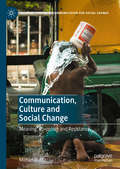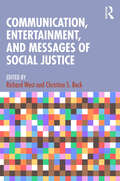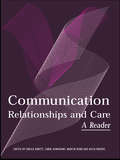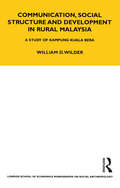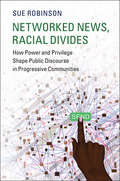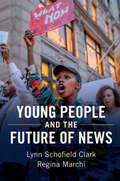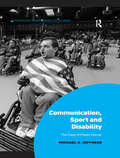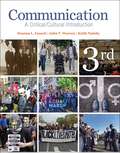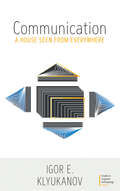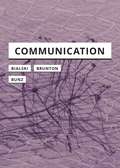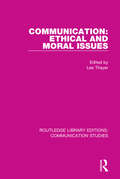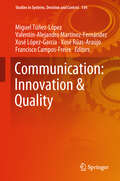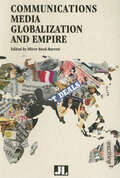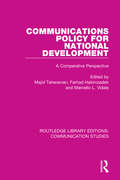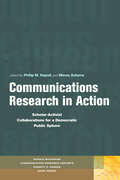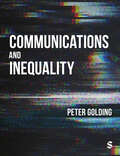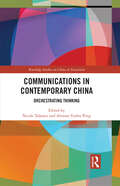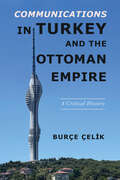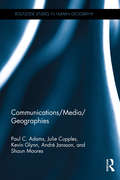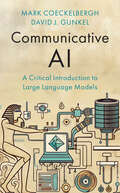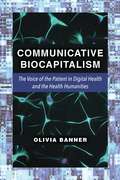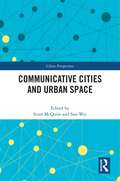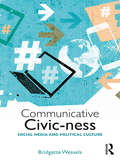- Table View
- List View
Communication, Culture and Social Change: Meaning, Co-option and Resistance (Palgrave Studies in Communication for Social Change)
by Mohan DuttaDrawing on the culture-centered approach (CCA), this book re-imagines culture as a site for resisting the neocolonial framework of neoliberal governmentality. Culture emerged in the 20th Century as a conceptual tool for resisting the hegemony of West-centric interventions in development, disrupting the assumptions that form the basis of development. This turn to culture offered radical possibilities for decolonizing social change but in response, necolonial development institutions incorporated culture into their strategic framework while simultaneously deploying political and economic power to silence transformative threads. This rise of “culture as development” corresponded with the global rise of neo-liberal governmentality, incorporating culture as a tool for globally reproducing the logic of capital. Using examples of transformative social change interventions, this book emphasizes the role of culture as a site for resisting capitalism and imagining rights-based, sustainable and socialist futures. In particular, it attends to culture as the basis for socialist organizing in activist and party politics. In doing so, Culture, Participation and Social Change offers a framework of inter-linkage between Marxist analyses of capital and cultural analyses of colonialism. It concludes with an anti-colonial framework that re-imagines the academe as a site of activist interventions.
Communication, Entertainment, and Messages of Social Justice
by Richard West Christina S. BeckThis edited collection explores the contemporary interplay among three pivotal areas found in cultures around the world: communication, entertainment, and messages of social justice. Each chapter centralizes communication as instrumental in creating mediated messages pertaining to social justice, usually resulting in a more educated audience.Using an accessible writing style, the contributors investigate both classic and contemporary social media, television, film, stage, radio, and podcast productions by employing both qualitative and quantitative methods. Furthermore, through case studies on topics including transphobia, indigenous comedy and drag performance, this book assesses key issues and themes portrayed in contemporary entertainment education. It provides a foundational framework for analysis by utilizing a broad range of theoretical models to explore representations of race, class, gender, advocacy, and pedagogy among others as well as their communication implications.This book will be of interest to scholars and students in the fields of Communication Studies, Popular Culture Studies, Media Studies, Theatre Studies, Social Justice Studies, Sociology, and Psychology.
Communication, Relationships and Care: A Reader
by Carol Komaromy Martin Robb Sheila Barrett Anita Rogers<p>Communication and relationships have become an increasing focus of attention in debates about the future of health and social care. People working in care services are being encouraged to improve communication processes, to develop more participatory relationships with service users, and to work more closely in partnership with other professionals. <p>This Reader provides a comprehensive collection of literature that aims to enable those involved in care services, as workers, carers or service users, to reflect on their everyday interactions and to situate them in wider contexts. Including new material from the frontline of research and practice, as well as some classic readings, this wide-ranging volume emphasises the need to see interpersonal communication as embedded in relationships, and to take account of issues of power and diversity, as well as the emotional dimension of care work. Covering both health and social care, the Reader is divided into four sections, focusing on:* concepts and contexts* analysing aspects of communication* the person in the process* communication and relationships in organisations. <p>Communication, Relationships and Care will be an essential resource for students of social work, nursing, health and social policy, and for all involved in health and social care services, whether as professionals, carers or service users. It is a set book for the Open University's second level undergraduate course Communication and Relationships in Health and Social Care (K205).
Communication, Social Structure and Development in Rural Malaysia: A Study of Kampung Kuala Bera
by William WilderThis is an important innovative analysis of communication and society in Pahang, West Malaysia, based on fieldwork carried out in Kampung Kuala Bera. Dr Wilder is concerned with communication networks of all kinds as found in a long-established Malay village, including the uses of language, small-scale (kinship and village-based) networks, and higher-level systems (the district and the nation as a whole). Dr Wilder lays particular emphasis on the role of communication in the process of economic development and on administration during a period of rapid and induced social change. His study is prefaced by a detailed historical account of Pahang and a thorough sociological analysis of Kampung Kuala Bera. The ethnography is meticulously detailed; its special contribution includes the first-ever publication of a Malay village genealogy, a systematic account of birth-order names (a major feature of the kinship system), complete figures on marital breakdowns for the whole village population, and an intensive analysis of leadership in its local context. This work will be of value to students of Southeast Asian societies, rural sociology, network studies, economic development, political education and the mass media in third world countries.
Communication, Society and Politics: How Power and Privilege Shape Public Discourse in Progressive Communities (Communication, Society and Politics)
by Sue RobinsonAgainst conventional wisdom, pervasive black-white disparities pair with vitriolic public conversation in politically progressive communities throughout America. Networked News, Racial Divides examines obstacles to public dialogues about racial inequality and opportunities for better discourse in mid-sized, liberal cities. The book narrates the challenges faced when talking about race through a series of stories about each community struggling with K-12 education achievement gaps. Media expert Sue Robinson applies Bourdieusian field theory to understand media ecologies and analyze whose voices get heard and whose get left out. She explores how privilege shapes discourse and how identity politics can interfere with deliberation. Drawing on network analysis of community dialogues, interviews with journalists, politicians, activists, and citizens and deep case study of five cities, this reflexive and occasionally narrative book chronicles the institutional, cultural and other problematic realities to amplifying voices of all people while also recommending strategies to move forward and build trust.
Communication, Society and Politics: Social Media and the Rise of Connective Journalism (Communication, Society and Politics)
by Lynn Schofield ClarkYoung People and the Future of News traces the practices that are evolving as young people come to see news increasingly as something shared via social networks and social media rather than produced and circulated solely by professional news organizations. The book introduces the concept of connective journalism, clarifying the role of creating and sharing stories online as a key precursor to collective and connective political action. At the center of the story are high school students from low-income minority and immigrant communities who often feel underserved or misrepresented by mainstream media but express a strong interest in politics and their communities. Drawing on in-depth field work in three major urban areas over the course of ten years, Young People and the Future of News sheds light on how young people share news that they think others should know about, express solidarity, and bring into being new publics and counter-publics.
Communication, Sport and Disability: The Case of Power Soccer (Interdisciplinary Disability Studies)
by Michael S. JeffressSports are ubiquitous in American society, and given their prominence in the culture, it is easy to understand how most youth in the United States face pressure to participate in organized sports. But what does this mean for the hundreds of thousands of Americans who live with one or more physical disabilities and, in particular, those in powered wheelchairs? Located at the intersection of sports and disability, this book tells the story of power soccer - the first competitive team sport specifically designed for electric wheelchair users. Beginning in France in the 1970s, today, over sixty teams compete within the United States Power Soccer Association (USPSA) and the sport is actively played in over thirty countries. Using ethnographic research conducted while attending practices, games, and social functions of teams from across the nation, Jeffress builds a strong case that electric wheelchair users deserve more opportunity to play sports. They deserve it because they need the same physical and psychosocial benefits from participation as their peers, who have full use of their arms and legs. It challenges the social constructions and barriers that currently stand in the way. Most importantly, this book tells the story of some amazing power soccer athletes. It is a moving, first-hand account of what power soccer means to them and the implications this has for society.
Communication: A Critical/cultural Introduction
by Keith Nainby Deanna L. Fassett John T. WarrenThe third edition of Communication: A Critical/Cultural Introduction provides a comprehensive, yet focused, overview of communication theory, interpersonal communication, and public communication and culture through the lens of contemporary critical theory. The text shows how we produce our world through communication, challenging us to explore power, ideology, and diversity through daily interactions, both public and private. <P><P> The book begins with explanations of how communication relates to culture and power, how to distinguish between representative and constitutive communication, and how to build a message for an audience with an emphasis on social advocacy. Later chapters explore the responsibilities of speakers and listeners, alliance-building, the application of communication theory in the study of identity and perception, the relationship between language and culture, nonverbal communication, and more. The text closes with a discussion of communication as a means of social action, encouraging readers to use communication as a foundation for the advancement of issues that matter most to them.
Communication: A House Seen from Everywhere (Studies in Linguistic Anthropology #2)
by Igor E. KlyukanovFocusing on the scientific study of communication, this book is a systematic examination. To that end, the natural, social, cultural, and rational scientific perspectives on communication are presented and then brought together in one unifying framework of the semiotic square, showing how all four views are interconnected. The question of whether the study of communication can be considered a unique science is addressed. It is argued that communication is never separate from any object of study and thus we always deal with its manifestations, captured in the four scientific perspectives discussed in the book.
Communication: Essays On Communication, Materiality, And Society (In Search of Media)
by Mercedes Bunz Paula Bialski Finn BruntonOn contemporary communication in its various human and nonhuman formsContemporary communication puts us not only in conversation with one another but also with our machinery. Machine communication—to communicate not just via but also with machines—is therefore the focus of this volume. Diving into digital communications history, Finn Brunton brings to the fore the alienness of computational communication by looking at network timekeeping, automated trolling, and early attempts at communication with extraterrestrial life. Picking up this fascination with inhuman communication, Mercedes Bunz then performs a close reading of interaction design and interfaces to show how technology addresses humans (as very young children). Finally, Paula Bialski shares her findings from a field study of software development, analyzing the communicative forms that occur when code is written by separate people. Today, communication unfolds merely between two or more conscious entities but often includes an invisible third party. Inspired by this drastic shift, this volume uncovers new meanings of what it means &“to communicate.&”
Communication: Ethical and Moral Issues (Routledge Library Editions: Communication Studies #14)
by Lee ThayerThis pioneering book, on the ethical and moral dimensions of communication and communication systems in the modern world, was originally published in 1974. It derived from an International Symposium on communication, consisting of world-class scholars ranging from philosophy and anthropology, to cybernetics and psychiatry, and from literary criticism to the social and behavioural sciences. The uses of communication are ubiquitous. The breadth, depth, scope and reach of every human mind depends upon the communication experiences one has had, or is capable of having. How people confront one another depends upon the quality and reach of their individual minds – not solely on their words. This book provides an opportunity to explore with these far-ranging scholars the ethical, moral, and pragmatic communication dilemmas of our modern age. It is as pertinent today as it was when it was first published.
Communication: Innovation & Quality (Studies in Systems, Decision and Control #154)
by Miguel Túñez-López Valentín-Alejandro Martínez-Fernández Xosé López-García Xosé Rúas-Araújo Francisco Campos-FreireThis book explores the disruptive changes in the media ecosystem caused by convergence and digitization, and analyses innovation processes in content production, distribution and commercialisation. It has been edited by Professors Miguel Túñez-López (Universidade de Santiago de Compostela, Spain), Valentín-Alejandro Martínez-Fernández (Universidade da Coruña, Spain), Xosé López-García (Universidade de Santiago de Compostela, Spain), Xosé Rúas-Araújo (Universidade de Vigo, Spain) and Francisco Campos-Freire (Universidade de Santiago de Compostela, Spain). The book includes contributions from European and American experts, who offer their views on the audiovisual sector, journalism and cyberjournalism, corporate and institutional communication, and education. It particularly highlights the role of new technologies, the Internet and social media, including the ethics and legal dimensions. With 30 contributions, grouped into diverse chapters, on information preferences and uses in journalism, as well as public audiovisual policies in the European Union, related to governance, funding, accountability, innovation, quality and public service, it provides a reliable media resource and presents lines of future development.
Communications Media, Globalization, and Empire
by Oliver Boyd-BarrettAn exploration of the political economy of media, and to what extent global communications and popular entertainment continue to serve elite interests.In Communications Media, Globalization, and Empire, an international team of experts analyzes and critiques the political economy of media communications worldwide. Their analysis takes particular account of the sometimes conflicting pressures of globalization and “neo-imperialism.” The first is commonly defined as the dismantling of barriers to trade and cultural exchange and responds significantly to lobbying of the world’s largest corporations, including media corporations. The second concerns US pursuit of national security interests as response to “terrorism,” at one level and, at others, to intensifying competition among both nations and corporations for global natural resources.
Communications Policy for National Development (Routledge Library Editions: Communication Studies #13)
by Majid Teheranian Farhad Hakimzadeh Marcello L. VidaleOriginally published in 1977. Covering a wide international field and with the emphasis on communications in developing countries, this book contains chapters by eminent contributors looking at questions of policy, governance and planning in the field of mass communications. It also considers the role of the media in national development, multi-media education and critical theoretical issues bearing on the impact of modernization on traditional cultures. A few selected countries are discussed in detail – Iran, Brazil, India and the People’s Republic of Benin (then Dahomey) as well as the results of an international survey on the future of broadcasting. The book made recommendations for administrative reorganizations, network expansions and research requirements, some of which were implemented shortly afterwards.
Communications Research in Action: Scholar-Activist Collaborations for a Democratic Public Sphere (Donald McGannon Communication Research Center's Everett C. Parker Book Series)
by Philip M. Napoli Minna AslamaA synergy between academia and activism has long been a goal of both scholars and advocacy organizations in communications research. The essays in Communications Research in Action demonstrate, for the first time in one volume, how an effective partnership between the two can contribute to a more democratic public sphere by helping to break down the digital divide to allow greater access to critical technologies, democratizing the corporate ownership of the media industry, and offering myriad opportunities for varied articulation of individuals’ ideas.Essays spanning topics such as the effect of ownership concentration on children’s television programming, the media’s impact on community building, and the global consequences of communications research will not only be valuable to scholars, activists, and media policy makers but will also be instrumental in serving as a template for further exploration in collaboration.
Communications and Inequality: The Media and Citizenship in Class Societies
by Peter GoldingWith growing numbers of billionaires at one end and startling numbers of food banks at the other, ‘advanced’ industrial societies are becoming ever more unequal. Yet the evolution and widespread use of new digital media, and of a news-rich environment, bear the promise of unprecedentedly informed citizens and enriched democracy. Are both these trends possible? This book examines the evidence comprehensively, and argues that the link between communications and inequality has a profound and direct impact on the relationship between citizens and society. Drawing on key concepts in the sociological understanding of modern society, extensive explanation of the ‘digital divide’, the role and character of the new ‘tech giants’, and the powerful effects on society of the ‘voice’ of vested interests, it offers a unique analysis of the dynamics and wider implications of communications inequality.
Communications and Inequality: The Media and Citizenship in Class Societies
by Peter GoldingWith growing numbers of billionaires at one end and startling numbers of food banks at the other, ‘advanced’ industrial societies are becoming ever more unequal. Yet the evolution and widespread use of new digital media, and of a news-rich environment, bear the promise of unprecedentedly informed citizens and enriched democracy. Are both these trends possible? This book examines the evidence comprehensively, and argues that the link between communications and inequality has a profound and direct impact on the relationship between citizens and society. Drawing on key concepts in the sociological understanding of modern society, extensive explanation of the ‘digital divide’, the role and character of the new ‘tech giants’, and the powerful effects on society of the ‘voice’ of vested interests, it offers a unique analysis of the dynamics and wider implications of communications inequality.
Communications in Contemporary China: Orchestrating Thinking (Routledge Studies on China in Transition)
by Nicole Talmacs Altman Yuzhu PengUsing the analogy of an orchestra, the book looks at the ways in which the Party-state conducts communications in China. Rather than treating China’s communications system as purely one of centralised top-down control, this book proffers that it is the combination of the government through its state policies, the propaganda bureau’s campaigns, commercial consumer culture, digital and traditional media platforms, celebrities, entertainers and journalists, educators, community interest groups, and family and friends, who all contribute to the evolution of how ideas are perpetuated, enforced, and legitimised in China. Covering themes such as censorship, surveillance, national narratives onscreen and in everyday life, political agency, creative work, news production, and gender politics, this book gives an insight into the complex web of conditions, objectives, and challenges that the Chinese leadership and commercial interests face when orchestrating their visions for the nation’s future. As such, this volume will be of great interest to students and scholars of media and communication studies, Chinese politics, and Chinese Studies.
Communications in Turkey and the Ottoman Empire: A Critical History (The Geopolitics of Information)
by Burçe ÇelikDe-Westernizing the communications history of Turkey and its imperial predecessor The history of communications in the Ottoman Empire and Turkey contradicts the widespread belief that communications is a byproduct of modern capitalism and other Western forces. Burçe Çelik uses a decolonial perspective to analyze the historical commodification and militarization of communications and how it affected production and practice for oppressed populations like women, the working class, and ethnic and religious minorities. Moving from the mid-nineteenth century through today, Çelik places networks within the changing geopolitical landscape and the evolution of modern capitalism in relationship to struggles involving a range of social and political actors. Throughout, she challenges Anglo- and Eurocentric assumptions that see the non-West as an ahistorical imitation of, or aberration from, the development of Western communications. Ambitious and comprehensive, Communications in Turkey and the Ottoman Empire merges political economy with social history to challenge Western-centered assumptions about the origins and development of modern communications.
Communications in the Building Industry: The report of a pilot study
by Gurth Higgin Neil JessopTavistock Press was established as a co-operative venture between the Tavistock Institute and Routledge & Kegan Paul (RKP) in the 1950s to produce a series of major contributions across the social sciences. This volume is part of a 2001 reissue of a selection of those important works which have since gone out of print, or are difficult to locate. Published by Routledge, 112 volumes in total are being brought together under the name The International Behavioural and Social Sciences Library: Classics from the Tavistock Press. Reproduced here in facsimile, this volume was originally published in 1965 and is available individually. The collection is also available in a number of themed mini-sets of between 5 and 13 volumes, or as a complete collection.
Communications/Media/Geographies (Routledge Studies in Human Geography)
by Julie Cupples Kevin Glynn Shaun Moores André Jansson Paul C. AdamsAlthough there are human geographers who have previously written on matters of media and communication, and those in media and communication studies who have previously written on geographical issues, this is the first book-length dialogue in which experienced theorists and researchers from these different fields address each other directly and engage in conversation across traditional academic boundaries. The result is a compelling discussion, with the authors setting out statements of their positions before responding to the arguments made by others. One significant aspect of this discussion is a spirited debate about the sort of interdisciplinary area that might emerge as a focus for future work. Does the already-established idea of communication geography offer the best way forward? If so, what would applied or critical forms of communication geography be concerned to do? Could communication geography benefit from the sorts of conjunctural analysis that have been developed in contemporary cultural studies? Might a further way forward be to imagine an interdisciplinary field of everyday-life studies, which would draw critically on non-representational theories of practice and movement? Readers of Communications/Media/Geographies are invited to join the debate, thinking through such questions for themselves, and the themes that are explored in this book (for example, of space, place, meaning, power, and ethics) will be of interest not only to academics in human geography and in media and communication studies, but also to a wider range of scholars from across the humanities and social sciences.
Communicative AI: A Critical Introduction to Large Language Models
by David J. Gunkel Mark CoeckelberghLarge Language Models (LLMs), like OpenAI’s ChatGPT and Google’s LaMDA, are not only the most disruptive and controversial technologies of our time, but also offer an unprecedented opportunity to examine human cognition and philosophically question the very nature of language, communication, and intelligence. What is consciousness? What is language? Are LLMs authors? Are LLMs the end of writing as we know it?In Communicative AI, Mark Coeckelbergh and David J. Gunkel offer a critical introduction to LLMs, investigating the philosophical significance of this technology and its practical ramifications. Mobilizing resources from contemporary philosophy, history of ideas, linguistics, and communication theory, the book invites us to re-think some long-standing philosophical issues concerning language, consciousness, truth, authorship, and writing. Through a blend of theoretical analysis, accessible explanations, and practical examples, the book provides readers with a comprehensive overview of the role that this powerful new technology is already playing in our lives.This is a must-read for students and scholars across the humanities and the social sciences, as well as for anyone intrigued by the intersection of technology, language, and human thought.
Communicative Biocapitalism: The Voice of the Patient in Digital Health and the Health Humanities
by Olivia BannerThe Precision Medicine Initiative, Apple’s HealthKit, the FitBit—the booming digital health industry asserts that digital networks, tools, and the scientific endeavors they support will usher in a new era of medicine centered around “the voice of the patient.” But whose “voices” do such tools actually solicit? And through what perspective will those voices be heard? Digital health tools are marketed as neutral devices made to help users take responsibility for their health. Yet digital technologies are not neutral; they are developed from an existing set of assumptions about their potential users and contexts for use, and they reflect dominant ideologies of health, dis/ability, gender, and race. Using patient-networking websites, the Quantified Self, and online breast cancer narratives, Communicative Biocapitalism examines the cultural, technological, economic, and rhetorical logics that shape the “voice of the patient” in digital health to identify how cultural understandings and social locations of race, gender, and disability intertwine with whose voices are elicited and how they are interpreted.
Communicative Cities and Urban Space (China Perspectives)
by Scott McQuireCities have long been recognized as key sites for fostering new communication practices. However, as contemporary cities experience major changes, how do diverse inhabitants encounter each other? How do cities remember? What is the role of the built environment in fostering sites for public communication in a digital era? Communicative Cities and Urban Space offers a critical analysis of contemporary changes in the relation between urban space and communication. This volume seeks to understand the situatedness of contemporary communication practices in diverse contexts of urban life, and to explore digitized urban space as a historically specific communicative environment. The essays in this book collectively propose that the concept of the ‘communicative city’ is a productive frame for rethinking the above questions in the context of 21st-century ‘media cities’. They challenge us to reconsider qualities such as openness, autonomy and diversity in contemporary urban communication practices, and to identify factors that might expand or constrict communicative possibilities. Students and scholars of communication studies and urban studies would benefit from this book.
Communicative Civic-ness: Social Media and Political Culture
by Bridgette WesselsCommunicative Civic-ness explores how political culture shapes social media interactions in civic participation, arguing that social media usage is informed by context-specific civil and political culture. Drawing on cutting-edge research, the book develops a new robust theoretical and conceptual framework on civic engagement and participation, comprising: contextual ethos of civic communication; political culture and civic communication; use of social media in private and public spheres; design of social media. It critically addresses issues within the concept of political culture and develops the concept of ‘communicative civic-ness’. This concept seeks to aid a better-informed debate about the capacity of social media to support the pluralistic discussions that underpin deliberative democratic processes. This book appeals to both undergraduate and postgraduate students, as well as academics with an interest in areas including (but not limited to) sociology, political science and media studies. It will also provide useful information and understanding to third sector organisations and policy-makers regarding forms of civic participation.
